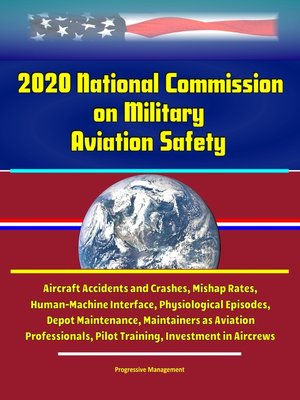2020 National Commission on Military Aviation Safety
ebook ∣ Aircraft Accidents and Crashes, Mishap Rates, Human-Machine Interface, Physiological Episodes, Depot Maintenance, Maintainers as Aviation Professionals, Pilot Training, Investment in Aircrews
By Progressive Management

Sign up to save your library
With an OverDrive account, you can save your favorite libraries for at-a-glance information about availability. Find out more about OverDrive accounts.
Find this title in Libby, the library reading app by OverDrive.



Search for a digital library with this title
Title found at these libraries:
| Library Name | Distance |
|---|---|
| Loading... |
Professionally converted for accurate flowing-text e-book format reproduction, this is a reproduction of the important report of the National Commission on Military Aviation Safety, issued in late 2020. The Commission reviewed thousands of mishap reports, consulted volumes of secondary research, and conducted data analysis to determine why mishap rates have increased. This report shares critical perspectives from the flight line and addresses the safety concerns that so many aviators and maintainers candidly shared. his report also covers broader topics in the Commission's statutory charter, such as aviation mishap rates, unexplained physiological episodes, and aviation maintenance delays. During its study, the Commission realized that many aviation safety issues are uniquely interconnected and require collaborative, cross-cutting solutions. For example, increasing spare parts inventories does little good if there are not enough experienced maintainers to install them. Fixing one issue may require fixing several related issues, and all solutions must be crafted to work in concert. In this report, the Commission took special care to balance competing and sometimes conflicting priorities, and its recommendations are proposed with an understanding of the importance of harmonization. Our findings and recommendations focus on four areas where Congress and the Department of Defense can take immediate steps to reduce aviation mishaps: Pilots should fly; maintainers should maintain; data can save lives; and funding should be consistent.
Executive Summary * Aircrews and Maintainers * Data Deficiencies and the Need for a Joint Safety Council * Consistent and Predictable Resourcing * Conclusion * Mission and Method * Conducting Its Study * The Human-Machine-Environment Framework * Chapter 2: Assessing Mishap Rates * Assessing and Characterizing Mishap Rates * Visualizing and Contextualizing the Rates * Comparing the Period Means * Identifying Troubling Trends * The Commission's Assessment and Findings * Additional Assessment * Chapter 3: Military Aviation Safety Data * Assessing the Causes and Contributing Factors of Mishaps * The Human Factors Analysis and Classification System (HFACS) * The Limitations * Preemptive Aviation Safety Data Collection * Chapter 4: The Joint Safety Council * The Safety Success of Commercial Aviation * Establishing a Joint Safety Council * Chapter 5: The Human/Machine Interface * Physiological Episodes * No Single Problem, No Single Solution * Prioritizing the Human * Chapter 6: Sustaining the Machine * Aviation Supply System * Overcoming Supply Deficiencies * Depot Maintenance Facilities * Aircraft Transition Issues * Chapter 7: The Need for Consistent and Predictable Funding * Continuing Resolutions * Chapter 8: The Demand Environment * More Demand than Capacity * Additional Duties * Chapter 9: Maintainers as Aviation Professionals * Measuring Training Efficacy * On-the-Job Training * Experience Matters * Talent Management for Aviation Maintainers * Maintainers Want to Maintain * Chapter 10: Protecting Investment in Aircrews * Pilot Training * The Right Training Medium * In Memoriam * Appendixes * A. Congressional Charter for the National Commission on Military Aviation Safety * B. Recommendations * C. Commissioners and Staff * D. Commission Engagements * E. Bibliography * F. Technical Appendix * G. Key Military Aviation Safety Policy Guidance







